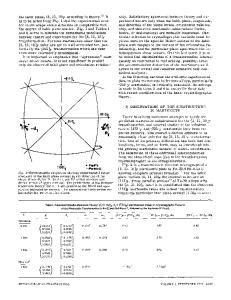Tempering of Iron-Carbon-Nitrogen martensites
- PDF / 2,856,139 Bytes
- 17 Pages / 630 x 792 pts Page_size
- 80 Downloads / 333 Views
I.
INTRODUCTION
E X T E N S I V E studies on the aging and tempering behavior of interstitial iron-based martensites have been performed with either, and in particular, carbon [t-sl or nitrogen f9-14l as interstitial atoms. Iron-carbon and ironnitrogen martensites appear to be similar in many respects, e.g., comparable Ms temperatures t~Sl and lattice parameters. 061 However, distinct differences are observed on aging at room temperature I6'14[ and tempering. 14,13lFor example, on aging at room temperature, local enrichments of interstitial atoms develop in both carbon and nitrogen martensites, but the local enrichments in FeN martensite exhibit an ordered distribution of nitrogen atoms similar to that in the a"-Fe16N2 crystal structure, I~4] whereas such an ordering could not be demonstrated (until now) for the carbon atoms in the local enrichments in FeC martensite; I6] recently preprecipitation in FeC martensite was discussed in terms of a clustering-ordering synergy, rTl Thus, the transition and "equilibrium" nitrides produced on tempering FeN martensite have crystal structures very different from those of the transition and equilibrium carbides produced on tempering FeC martensite. In view of such differences, a study on the preprecipitation behavior of ternary FeCN martensitic alloys, especially for various ratios of the amounts of nitrogen and carbon atoms, is of interest. Knowledge on the tempering of FeCN martensitic alloys is also of practical importance, because these ternary martensites occur in carbonitrided workpieces. Until now, only a few results were reported on the tempering of FeCN martensite, llT"181 Furthermore, these data t17'~8~pertain to FeCN alloys very
LIU CHENG, formerly Graduate Student, Laboratory of Metallurgy, Delft University of Technology, is with Hoogooens BV, 1970 CA Ymuiden, The Netherlands. A. BOTTGER, Scientist, and E.J. MITTEMEIJER, Professor, are with the Laboratory of Metallurgy, Delft University of Technology, 2628 AL Delft, The Netherlands. Manuscript submitted June 3, 1991. METALLURGICAL TRANSACTIONS A
rich in nitrogen, which hinders the detection of the mutual effects of carbon and nitrogen on the tempering process. In this article, the results of a study on the tempering of FeCN martensitic alloys with an approximately constant amount of interstitials per iron atom and a variable ratio of carbon content to nitrogen content are given. The alloys contained a total amount of interstitials of about 5.5 at. pct, while the carbon and nitrogen contents varied between about 1.5 and 3.9 at. pct. Four techniques, X-ray diffraction analysis, hardness testing, dilatometry (thermal mechanical analysis (TMA), and differential scanning calorimetry (DSC), were applied to study the tempering process up to about 830 K. The present results were compared with those obtained previously for the tempering of pure FeC and FeN martensitic alloys.
II.
EXPERIMENTAL PROCEDURES
A. Specimen Preparation The specimens were prepared from pure iron (0.005 wt pct C, 0.0003 wt pct N, 0.01 wt pct O,
Data Loading...











